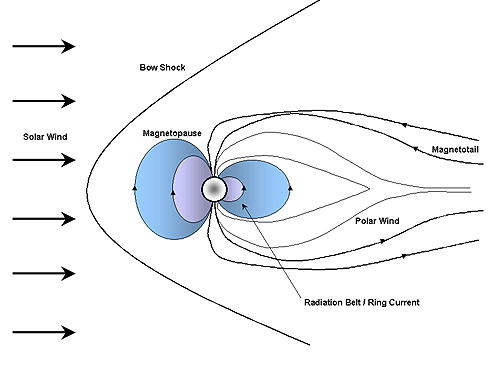The interplay between the Sun’s magnetic field and the Earth’s field is an area only recently investigated with vigor (past 100 years). There are not yet field equations that can explain or predict all the complex interactions, and many areas of inquiry only have hypothesis to stand upon, as no experimental methodologies have yet been created to test them into theories. The combination of modeling atmospheric effects (fluid dynamics) combined with magnetic fields (Maxwell’s equations) create the new science called Magnetohydrodynamics (MHD), and at the present time, the equations of MHD cannot be completely solved analytically. Geophysics and Solar-Terrestrial mechanics are still open frontiers for discovery and I believe that many assumptions that are taken as fact today, will in the future be as equally as amusing and discredited as the Flat Earth theory. Plate Tectonics coupled with slow motion geological changes is one area that may be challenged.
A two dimensional and labeled representation of the magnetosphere with solar interaction is presented next:
Before continuing further, a few terms should be defined:
Solar Flare - The sun has bands that rotate at different speeds and in different directions. These bands are not visible in the visible light spectrum, but can be seen via X-rays and radio wave emissions, over long intervals of time. As the bands flow against each other, magnetic fields develop large differentials in polarity. Once the differential has increased to the point that it is larger than the containing electromagnetic field of the Sun, the local differential explodes like an over-wound rubber band that snapped. The resulting jet of plasma gas is called a solar flare. The sun is continually roiling and bubbling, emitting flares large and small across the whole surface all the time.
Coronal Mass Ejection - The outer solar atmosphere, the corona, is structured by strong magnetic fields. Where these fields are closed, often above sunspot groups, the confined solar atmosphere can suddenly and violently release bubbles or tongues of gas and magnetic fields called coronal mass ejections. A large CME can contain over a billion tons of matter that can be accelerated to several million miles per hour in a spectacular explosion. Solar material streaks out through the interplanetary medium, impacting any planets or spacecraft in its path. CMEs are sometimes associated with flares but usually occur independently.
Coronal Hole - Coronal holes are variable solar features that can last for months to years. They are seen as large, dark holes when the Sun is viewed in x-ray wavelengths. These holes are rooted in large cells of unipolar magnetic fields on the Sun's surface; their field lines extend far out into the solar system. These open field lines allow a continuous outflow of high-velocity solar wind. Coronal holes have a long-term cycle, but it doesn't correspond exactly to the sunspot cycle; they holes tend to be most numerous in the years following sunspot maximum. At some stages of the solar cycle, these holes are continuously visible at the solar north and south poles.
Solar Wind - The solar wind flows around obstacles such as planets, but those planets with their own magnetic fields respond in specific ways. Earth's magnetic field is very similar to the pattern formed when iron filings align around a bar magnet. Under the influence of the solar wind, these magnetic field lines are compressed in the sunward direction and stretched out in the downwind direction. This creates the magnetosphere, a complex, teardrop-shaped cavity around Earth. The Van Allen radiation belts are within this cavity, as is the ionosphere, a layer of Earth's upper atmosphere where photo ionization by solar x-rays and extreme ultraviolet rays creates free electrons. Earth's magnetic field senses the solar wind components and reacts, to its speed, density, and magnetic field. Because the solar wind varies over time scales as short as seconds, the interface that separates interplanetary space from the magnetosphere is very dynamic. Normally this interface, called the magnetopause, lies at a distance equivalent to about 10 Earth radii in the direction of the Sun. However, during episodes of elevated solar wind density or velocity, the magnetopause can be pushed inward to within 6.6 Earth radii (the altitude of geosynchronous satellites). As the magnetosphere extracts energy from the solar wind, internal processes produce geomagnetic storms.
Geomagnetic Storm - One to four days after a flare or eruptive prominence occurs, a slower cloud of solar material and magnetic fields reaches Earth, buffeting the magnetosphere and resulting in a geomagnetic storm. These storms are extraordinary variations in Earth's surface magnetic field. During a geomagnetic storm, portions of the solar wind's energy is transferred to the magnetosphere, causing Earth's magnetic field to change rapidly in direction and intensity and energize the particle populations within it.
Copyright © 2001 Jared Freedman
